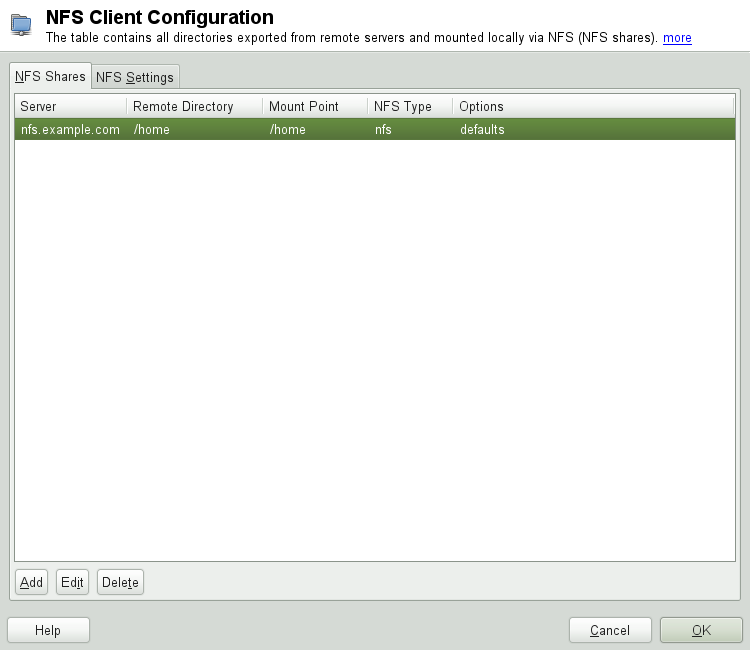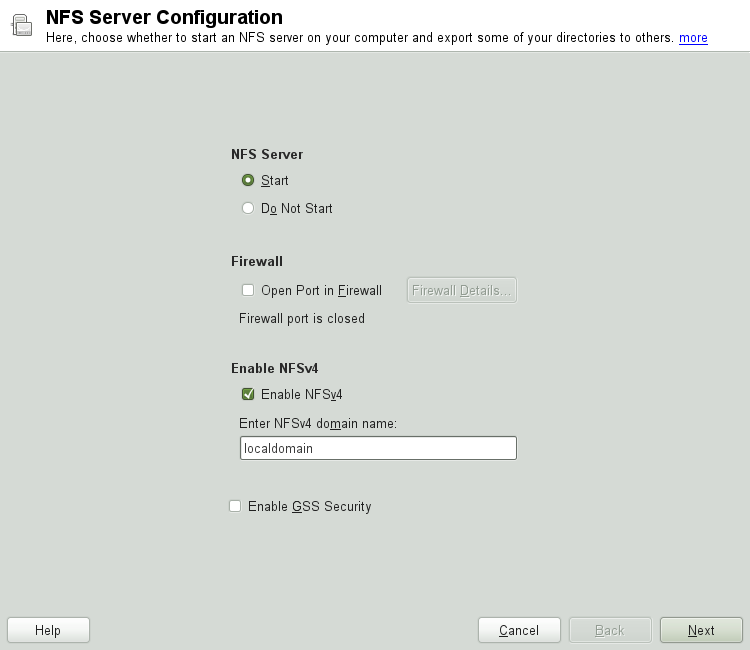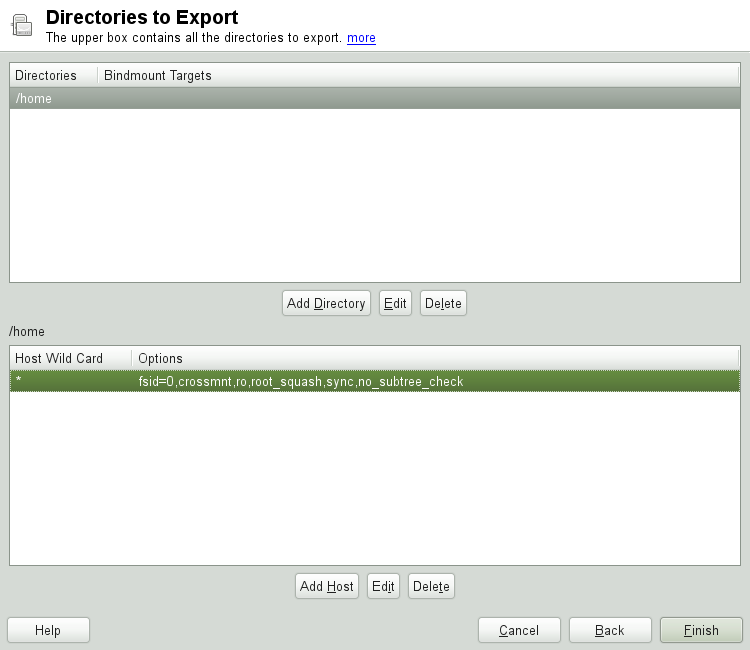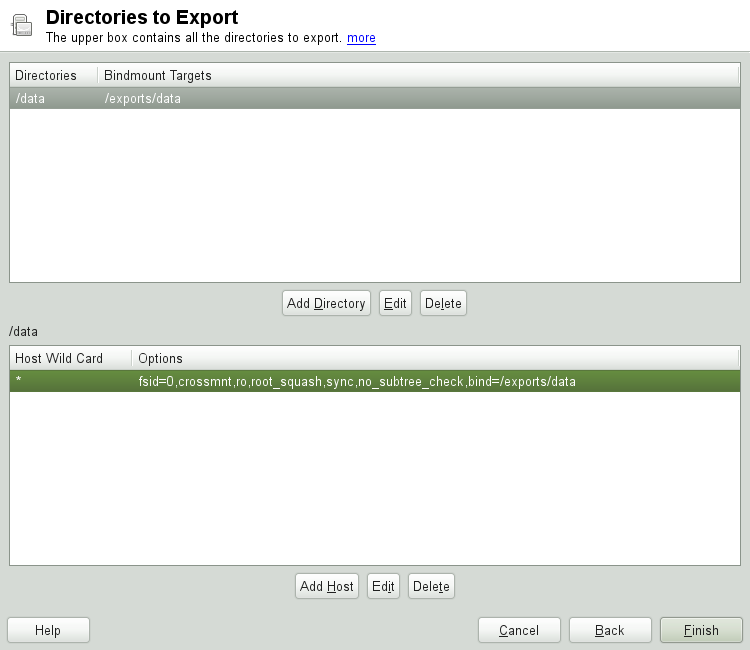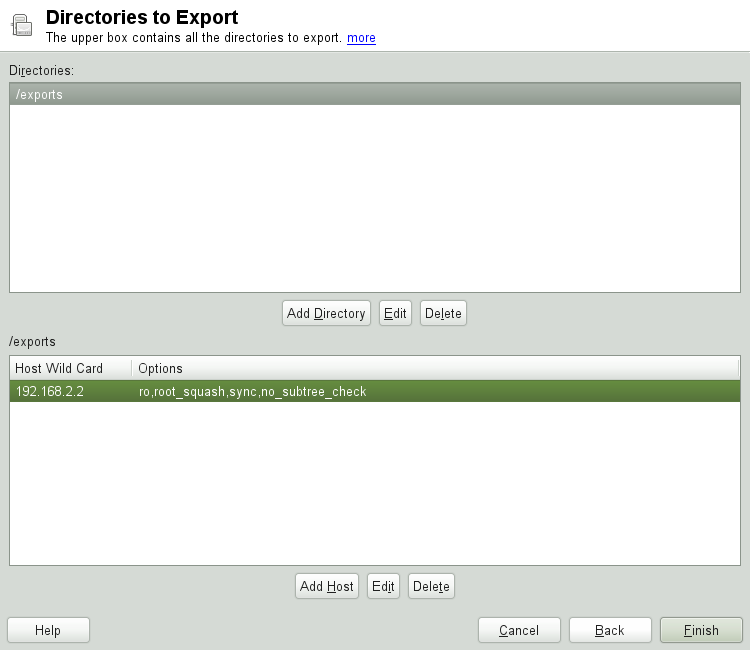Chapter 28. Sharing File Systems with NFS¶
Contents
Distributing and sharing file systems over a network is a common task in
corporate environments. The proven NFS system
works together with NIS, the yellow pages
protocol. For a more secure protocol that works together with
LDAP and may also be kerberized, check
NFSv4.
NFS with NIS makes a network transparent to the user. With NFS, it is possible to distribute arbitrary file systems over the network. With an appropriate setup, users always find themselves in the same environment regardless of the terminal they currently use.
Like NIS, NFS is a client/server system. However, a machine can be both—it can supply file systems over the network (export) and mount file systems from other hosts (import).
![[Important]](admon/important.png) | Need for DNS |
|---|---|
In principle, all exports can be made using IP addresses only. To avoid time-outs, you need a working DNS system. DNS is necessary at least for logging purposes, because the mountd daemon does reverse lookups. | |
28.1. Installing the Required Software¶
To configure your host as an NFS client, you do not need to install additional software. All needed packages are installed by default.
NFS server software is not part of the default installation. To install
the NFS server software, start YaST and select
+. Now choose
+ and select or use the option and search
for NFS Server. Confirm the installation of the
packages to finish the installation process.
28.2. Importing File Systems with YaST¶
Authorized users can mount NFS directories from an NFS server into the local file tree using the YaST NFS client module. Click on and enter the hostname of the NFS server, the directory to import, and the mount point at which to mount this directory locally. The changes will take effect after is clicked in the first dialog.
In the tab, enable to allow access to the service from remote computers.
The firewall status is displayed next to the check box. When using NFSv4,
make sure that the checkbox is enabled,
and that the contains the same value
as used by the NFSv4 server. The default domain is
localdomain.
Click to save your changes. See Figure 28.1, “NFS Client Configuration with YaST”.
The configuration is written to /etc/fstab and the
specified file systems are mounted. When you start the YaST
configuration client at a later time, it also reads the existing
configuration from this file.
28.3. Importing File Systems Manually¶
The prerequisite for importing file systems manually from an NFS server
is a running RPC port mapper. Start it by entering rcrpcbind
start as
root. Then remote file
systems can be mounted in the file system like local partitions using
mount:
mounthost:remote-pathlocal-path
To import user directories from the nfs.example.com
machine, for example, use:
mount nfs.example.com:/home /home
28.3.1. Using the Automount Service¶
The autofs daemon can be used to mount remote file systems
automatically. Add the following entry in the your
/etc/auto.master file:
/nfsmounts /etc/auto.nfs
Now the /nfsmounts directory acts as the root for
all the NFS mounts on the client if the auto.nfs
file is filled appropriately. The name auto.nfs is
chosen for the sake of convenience—you can choose any name. In
auto.nfs add entries for all the NFS mounts as
follows:
localdata -fstype=nfs server1:/data nfs4mount -fstype=nfs4 server2:/
Activate the settings with rcautofs start as
root. In this example, /nfsmounts/localdata,
the /data directory of
server1, is mounted with NFS and
/nfsmounts/nfs4mount from
server2 is mounted with NFSv4.
If the /etc/auto.master file is edited while the
service autofs is running, the automounter must be restarted for the
changes to take effect with rcautofs restart.
28.3.2. Manually Editing /etc/fstab¶
A typical NFSv3 mount entry in /etc/fstab looks
like this:
nfs.example.com:/data /local/path nfs rw,noauto 0 0
NFSv4 mounts may also be added to the /etc/fstab
file. For these mounts, use nfs4 instead of
nfs in the third column and make sure that the remote
file system is given as / after the
nfs.example.com: in the first column. A sample line
for an NFSv4 mount in /etc/fstab looks like this:
nfs.example.com:/ /local/pathv4 nfs4 rw,noauto 0 0
The noauto option prevents the file system from being
mounted automatically at start up. If you want to mount the respective
file system manually, it is possible to shorten the mount command
specifying the mount point only:
mount /local/path
Note, that if you do not enter the noauto option, the
initialization scripts of the system will handle the mount of those file
systems at start up.
28.4. Exporting File Systems with YaST¶
With YaST, turn a host in your network into an NFS server—a server that exports directories and files to all hosts granted access to it. This could be done to provide applications to all members of a group without installing the applications locally on each and every host. To install such a server, start YaST and select +; see Figure 28.2, “NFS Server Configuration Tool”.
Then activate and enter the .
Click if you need secure access to the server. A prerequisite for this is to have Kerberos installed on your domain and to have both the server and the clients kerberized. Click .
In the upper text field, enter the directories to export. Below, enter
the hosts that should have access to them. This dialog is shown in
Figure 28.3, “Configuring an NFS Server with YaST”. The
figure shows the scenario where NFSv4 is enabled in the previous dialog.
Bindmount Targets is shown in the right pane. For more
details, click . In the lower half of the dialog,
there are four options that can be set for each host: single
host, netgroups, wildcards,
and IP networks. For a more thorough explanation of
these options, refer to the exports man page. Click
to complete the configuration.
![[Important]](admon/important.png) | Automatic Firewall Configuration |
|---|---|
If a firewall is active on your system (SuSEfirewall2), YaST adapts
its configuration for the NFS server by enabling the
| |
28.4.1. Exporting for NFSv4 Clients¶
Activate to support NFSv4 clients. Clients with NFSv3 can still access the server's exported directories if they are exported appropriately. This is explained in detail in Section 28.4.3, “Coexisting v3 and v4 Exports”.
After activating NFSv4, enter an appropriate domain name. Make sure the
name is the same as the one in the
/etc/idmapd.conf file of any NFSv4 client that accesses this
particular server. This parameter is for the idmapd service that is
required for NFSv4 support (on both server and client). Leave it as
localdomain (the default) if you do not have special
requirements. For more information, see the links in
Section 28.7, “For More Information”.
Click . The dialog that follows has two sections. The upper half consists of two columns named and . is a directly editable column that lists the directories to export.
For a fixed set of clients, there are two types of directories that can be exported—directories that act as pseudo root file systems and those that are bound to some subdirectory of the pseudo file system. This pseudo file system acts as a base point under which all file systems exported for the same client set take their place. For a client or set of clients, only one directory on the server can be configured as pseudo root for export. For this client, export multiple directories by binding them to some existing subdirectory in the pseudo root.
In the lower half of the dialog, enter the client (wild card) and export options for a particular directory. After adding a directory in the upper half, another dialog for entering the client and option information pops up automatically. After that, to add a new client (client set), click .
In the small dialog that opens, enter the host wild card. There are four
possible types of host wild cards that can be set for each host: a
single host (name or IP address), netgroups, wild cards (such as
* indicating all machines can access the server), and
IP networks. Then, in , include
fsid=0 in the comma-separated list of options to
configure the directory as pseudo root. If this directory needs to be
bound to another directory under an already configured pseudo root, make
sure that a target bind path is given in the option list with
bind=/target/path.
For example, suppose that the directory /exports is
chosen as the pseudo root directory for all the clients that can access
the server. Then add this in the upper half and make sure that the
options entered for this directory include fsid=0. If
there is another directory, /data, that also needs
to be NFSv4 exported, add this directory to the upper half. While
entering options for this, make sure that
bind=/exports/data is in the list and that
/exports/data is an already existing subdirectory
of /exports. Any change in the option
bind=/target/path, whether addition, deletion,
or change in value, is reflected in . This column is not a directly editable column, but
instead summarizes directories and their nature. After all information
is provided, click to complete the
configuration. The service will become available immediately.
28.4.2. NFSv3 and NFSv2 Exports¶
Make sure that is not checked in the initial dialog before clicking .
The next dialog has two parts. In the upper text field, enter the
directories to export. Below, enter the hosts that should have access to
them. There are four types of host wild cards that can be set for each
host: a single host (name or IP address), netgroups, wild cards (such as
* indicating all machines can access the server), and
IP networks.
This dialog is shown in Figure 28.5, “Exporting Directories with NFSv2 and v3”. Find a more thorough explanation of these options in man exports. Click to complete the configuration.
28.4.3. Coexisting v3 and v4 Exports¶
Both, NFSv3 and NFSv4 exports can coexist on a server. After enabling
the support for NFSv4 in the initial configuration dialog, those exports
for which fsid=0 and
bind=/target/path are not included in the
option list are considered v3 exports. Consider the example in
Figure 28.3, “Configuring an NFS Server with YaST”. If you
add another directory, such as /data2, using
then in the corresponding options list
do not mention either fsid=0 or
bind=/target/path, this export acts as a v3
export.
![[Important]](admon/important.png) | |
Automatic Firewall Configuration
If SuSEfirewall2 is active on your system, YaST adapts its
configuration for the NFS server by enabling the | |
28.5. Exporting File Systems Manually¶
The configuration files for the NFS export service are
/etc/exports and
/etc/sysconfig/nfs. In addition to these files,
/etc/idmapd.conf is needed for the NFSv4 server
configuration. To start or restart the services, run the command
rcnfsserver restart. This also starts the
rpc.idmapd if NFSv4 is configured in
/etc/sysconfig/nfs. The NFS server depends on a
running RPC portmapper. Therefore, also start or restart the portmapper
service with rcrpcbind restart.
28.5.1. Exporting File Systems with NFSv4¶
NFSv4 is the latest version of NFS protocol available on openSUSE. Configuring directories for export with NFSv4 differs slightly from previous NFS versions.
28.5.1.1. /etc/exports¶
The /etc/exports file contains a list of entries.
Each entry indicates a directory that is shared and how it is shared. A
typical entry in /etc/exports consists of:
/shared/directory host(option_list)
For example:
/export 192.168.1.2(rw,fsid=0,sync,crossmnt) /export/data 192.168.1.2(rw,bind=/data,sync)
Here the IP address 192.168.1.2 is used to identify
the allowed client. You can also use the name of the host, a wild card
indicating a set of hosts (*.abc.com,
*, etc.), or netgroups
(@my-hosts).
The directory which specifies fsid=0 is special in
that it is the root of the filesystem that is exported, sometime
referred to as the pseudo root filesystem. This directory must also
have the crossmnt for correct operation with NFSv4.
All other directories exported via NFSv4 must be mounted below this
point. If you want to export a directory that is not within the
exported root, it needs to be bound into the exported tree. This can be
done using the bind= syntax.
In the example above, /data is not within
/export, so we export
/export/data, and specify that the
/data directory should be bound to that name. The
directory /export/data must exist and should
normally be empty.
When clients mount from this server, they just mount
servername:/ rather than
servername:/export. It is not necessary to mount
servername:/data, because it will automatically
appear beneath wherever servername:/ was mounted.
28.5.1.2. /etc/sysconfig/nfs¶
The /etc/sysconfig/nfs file contains a few
parameters that determine NFSv4 server daemon behavior. Importantly,
the parameter NFS4_SUPPORT must be set to
yes. NFS4_SUPPORT
determines whether the NFS server supports NFSv4 exports and clients.
28.5.1.3. /etc/idmapd.conf¶
Every user on a Linux machine has a name and ID. idmapd does the name-to-ID mapping for NFSv4 requests to the server and replies to the client. It must be running on both server and client for NFSv4, because NFSv4 uses only names for its communication.
Make sure that there is a uniform way in which usernames and IDs (uid) are assigned to users across machines that might probably be sharing file systems using NFS. This can be achieved by using NIS, LDAP, or any uniform domain authentication mechanism in your domain.
The parameter Domain must be set the same for both,
client and server in the /etc/idmapd.conf file. If
you are not sure, leave the domain as localdomain in
the server and client files. A sample configuration file looks like the
following:
[General] Verbosity = 0 Pipefs-Directory = /var/lib/nfs/rpc_pipefs Domain = localdomain [Mapping] Nobody-User = nobody Nobody-Group = nobody
For further reference, read the man page of idmapd
and idmapd.conf; man idmapd,
man idmapd.conf.
28.5.1.4. Starting and Stopping Services¶
After changing /etc/exports or
/etc/sysconfig/nfs, start or restart the NFS
server service with rcnfsserver restart. After
changing /etc/idmapd.conf, reload the
configuration file with the command killall -HUP
rpc.idmapd.
If the NFS service needs to start at boot time, run the command chkconfig nfsserver on.
28.5.2. Exporting File Systems with NFSv2 and NFSv3¶
This section is specific to NFSv3 and NFSv2 exports. Refer to Section 28.4.1, “Exporting for NFSv4 Clients” for exporting with NFSv4.
Exporting file systems with NFS involves two configuration files:
/etc/exports and
/etc/sysconfig/nfs. A typical
/etc/exports file entry is in the format:
/shared/directory host(list_of_options)
For example:
/export 192.168.1.2(rw,sync)
Here, the directory /export is shared with the host
192.168.1.2 with the option list
rw,sync. This IP address can be replaced with a
client name or set of clients using a wild card (such as
*.abc.com) or even netgroups.
For a detailed explanation of all options and their meaning, refer to the man page of exports (man exports).
After changing /etc/exports or
/etc/sysconfig/nfs, start or restart the NFS server
using the command rcnfsserver restart.
28.6. NFS with Kerberos¶
To use Kerberos authentication for NFS, GSS security must be enabled. To do so, select in the initial YaST NFS Server dialog. You must have a working Kerberos server to use this feature. YaST does not set up the server but just uses the provided functionality. If you want to use Kerberos authentication in addition to the YaST configuration, complete at least the following steps before running the NFS configuration:
Make sure that both the server and the client are in the same Kerberos domain. They must access the same KDC (Key Distribution Center) server and share their
krb5.keytabfile (the default location on any machine is/etc/krb5.keytab). For more information about Kerberos, see Chapter 6, Network Authentication with Kerberos (↑Security Guide).Start the gssd service on the client with rcgssd start.
Start the svcgssd service on the server with rcsvcgssd start.
For more information about configuring kerberized NFS, refer to the links in Section 28.7, “For More Information”.
28.7. For More Information¶
As well as the man pages of exports,
nfs, and mount, information about
configuring an NFS server and client is available in
/usr/share/doc/packages/nfsidmap/README. Online
documentation can be found at the following Web documents:
Find the detailed technical documentation online at SourceForge.
For instructions for setting up kerberized NFS, refer to NFS Version 4 Open Source Reference Implementation.
If you have questions on NFSv4, refer to the Linux NFSv4 FAQ.
